How to Make Durian Mochi? 7 Easy Steps!
Durian mochi, a sweet East Asian dessert, combines the creamy texture of durian fruit with the chewiness of mochi.
To make durian mochi, prepare a dough using glutinous rice flour, sugar, and water, then wrap it around a filling made from durian puree. Cook the mochi until translucent and serve it chilled for a unique tropical treat.
Making durian mochi involves several steps: preparing the mochi dough, creating the durian filling, assembling the mochi balls, and cooking them.
For example, you could start by mixing 1 cup of glutinous rice flour with 1/4 cup of sugar and 3/4 cup of water, adjusting as needed to get the right dough consistency.
The durian filling could be made by blending fresh or frozen durian flesh, without seeds, until it’s creamy and smooth.
Experience the exotic flavors of Southeast Asia with homemade durian mochi, a delightful blend of sweet and creamy wrapped in a chewy rice dough.

Key Takeaway
Gather Your Ingredients
Before commencing the preparation of Durian Mochi, ensure you have the chef’s selection of ingredients at hand.
This initial step is pivotal to the culinary process, establishing the foundation for a successful confection.
You will require premium-grade durian pulp, ensuring it is devoid of fibrous material and seeds. Accompany this with glutinous rice flour, a critical component for the mochi dough, which provides its characteristic chewy texture.
Additionally, procure caster sugar, water, and cornstarch—a requisite for dusting and preventing stickiness.
Precision in measurement and quality of ingredients will dictate the final product’s authenticity and flavor profile.
These components amalgamated with culinary skill result in a delicacy that resonates with tradition and innovation.
Step 1: Prepare the Mochi Dough
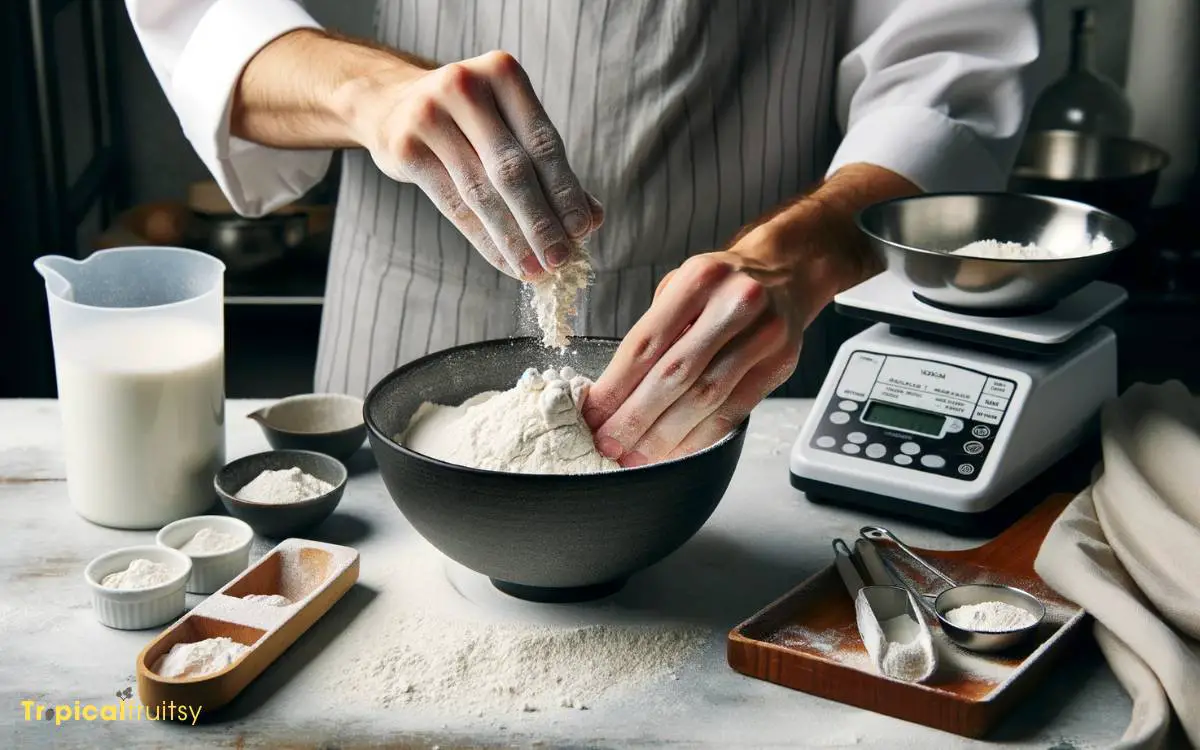
The foundation of mochi is its unique, chewy texture. This texture is achieved through the use of glutinous rice flour, which is necessary for authenticity and quality.
Precision in measuring the flour, water, and other ingredients is critical to achieving the correct consistency and flavor balance. Stirring the mixture to a smooth, homogeneous state will ensure an even texture in the final product.
Choose Right Flour
One must select a high-quality glutinous rice flour to ensure a smooth and pliable mochi dough for durian mochi.
This type of flour, also known as ‘sweet rice flour,’ is integral to achieving the unique sticky and chewy texture characteristic of mochi.
The selection process should prioritize:
- Purity: Ensure that the flour is 100% pure glutinous rice flour without any additives or fillers that could compromise the dough’s texture.
- Fineness: Opt for finely milled flour for a more refined and smooth consistency in the final mochi.
- Freshness: Check the packaging date to acquire the freshest stock, as older flour may affect the moisture balance and elasticity of the dough.
Employing the correct flour is essential for the successful preparation of durian mochi with the desired authentic texture.
Measure Ingredients Precisely
Proceed with precision by carefully measuring the glutinous rice flour, water, sugar, and any additional ingredients required for the mochi dough to ensure consistency and quality in your durian mochi.
Utilize a digital scale for accuracy, measuring glutinous rice flour to the gram. The ratio of dry to wet ingredients is critical: too much liquid and the dough becomes unmanageably sticky; too little and it turns crumbly.
Dissolve granulated sugar into lukewarm water to ensure an even distribution throughout the dough. Should the recipe call for flavorings or colorings, these must be measured with equal care, using standardized measuring spoons for small quantities.
Adhering to precise measurements is not merely pedantic—it is the foundation upon which the delicate texture and subtle sweetness of your mochi is built.
Mix to Consistency
Having established the importance of precise measurements, ingredient amalgamation is the next critical step in preparing the mochi dough for your durian mochi.
This phase is pivotal for achieving the characteristic chewiness and pliability of mochi. Careful attention is needed to ensure the components form a homogenous mixture with the right consistency.
- Glutinous Rice Flour: Begin by gradually incorporating water into the sifted glutinous rice flour to avoid lumps.
- Sugar Integration: Slowly add sugar to the mixture, ensuring it dissolves completely without altering the dough’s texture.
- Consistency Check: The dough should reach a smooth, sticky state without being overly wet. Adjust with minor flour or water additions as necessary.
This meticulous process sets the foundation for a successful mochi texture, integral for enveloping the rich durian filling.
Step 2: Cook the Mochi Dough
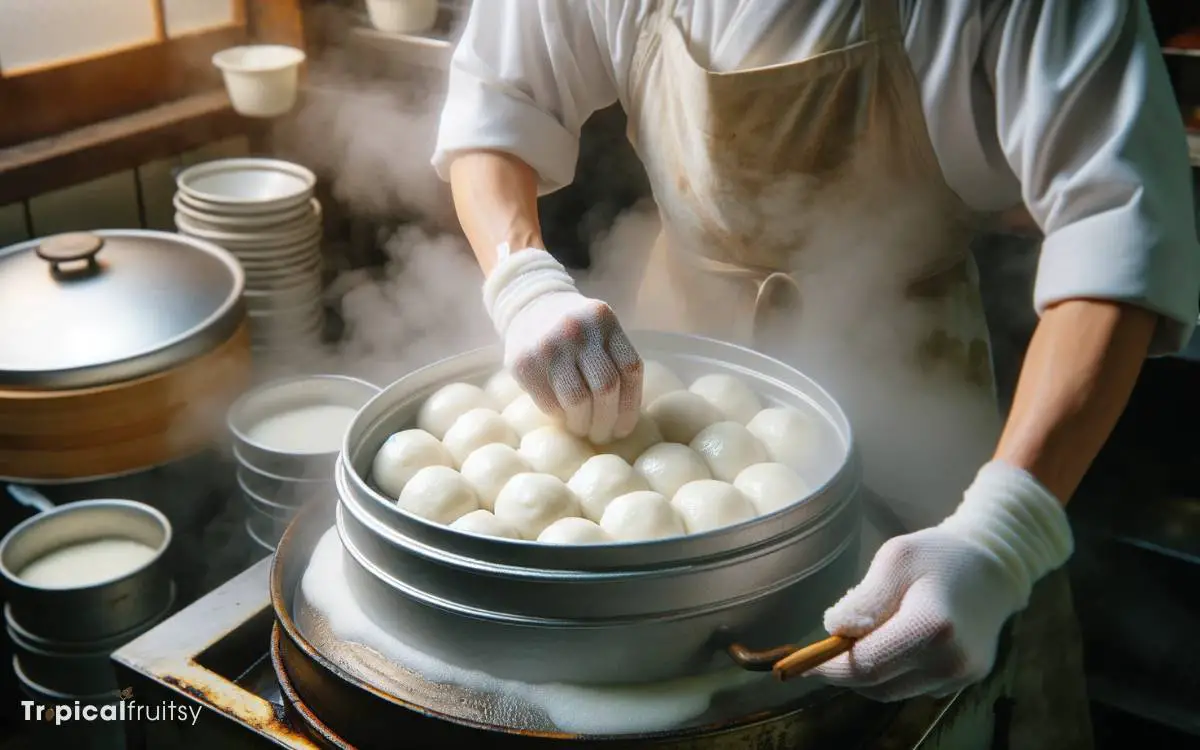
Begin preparing the mochi dough by whisking together glutinous rice flour, sugar, and water in a heatproof bowl until smooth.
The consistency should be homogeneous, free of lumps, and exhibit a slightly viscous flow. This preparation is crucial for achieving the tender, chewy texture synonymous with mochi.
| Step | Description |
|---|---|
| 1 | Whisk glutinous rice flour and sugar in a bowl. |
| 2 | Gradually add water until fully integrated. |
| 3 | Ensure a smooth, lump-free consistency. |
| 4 | Transfer to a heatproof bowl suitable for steaming. |
| 5 | Steam the mixture until it becomes translucent and sticky. |
Once steamed to perfection, the dough should be carefully stirred to attain an even texture throughout.
Step 3: Make the Durian Filling
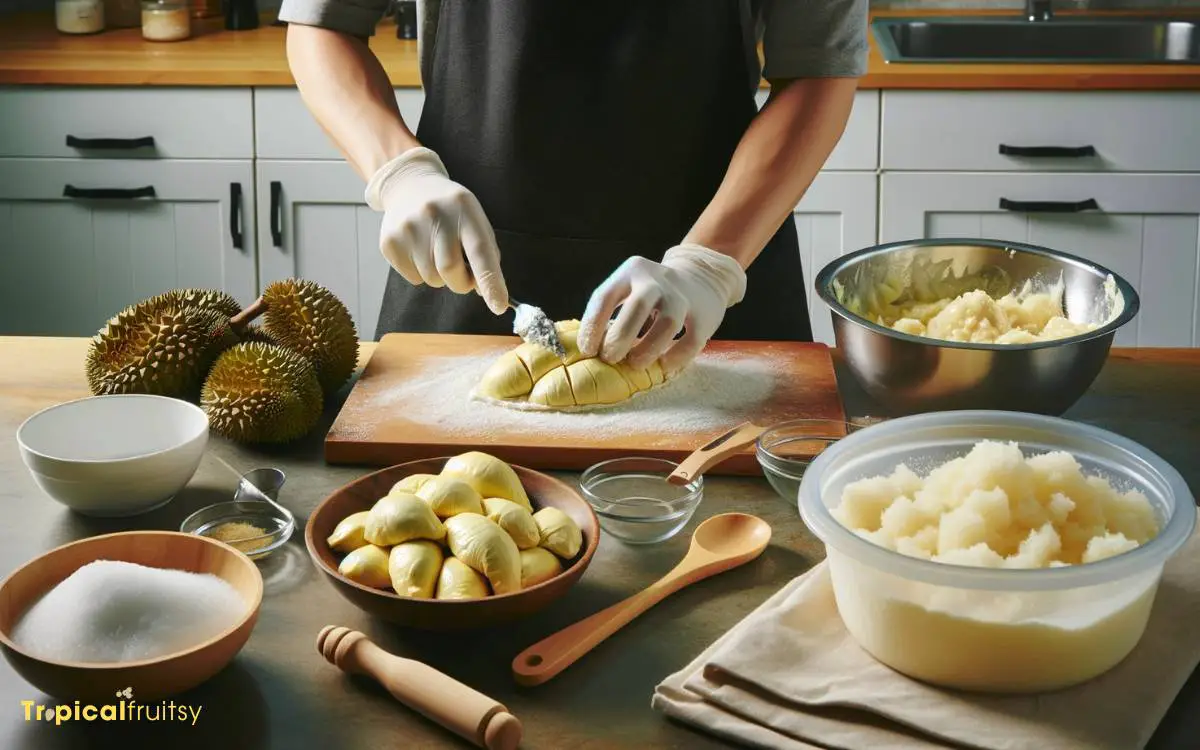
The durian puree serves as the core ingredient for the mochi’s rich and creamy filling. To achieve the desired consistency and flavor profile, a precise combination of durian flesh and other components must be blended until smooth.
This base will provide the characteristic taste that durian aficionados covet while ensuring the mochi’s filling maintains its structural integrity upon encasement.
- Puree Preparation: Select ripe durian fruit, remove seeds, and blend the flesh to a smooth consistency.
- Flavor Enhancement: Depending on preference, incorporate a sweetening agent such as condensed milk or sugar to balance the durian’s natural bitterness.
- Texture Refinement: For a luxurious mouthfeel, mix in a small amount of heavy cream or coconut milk until the filling achieves a velvety texture.
Utilize this filling judiciously within the mochi dough to ensure each piece is harmoniously flavored and texturally pleasing.
Step 4: Shape the Mochi Balls
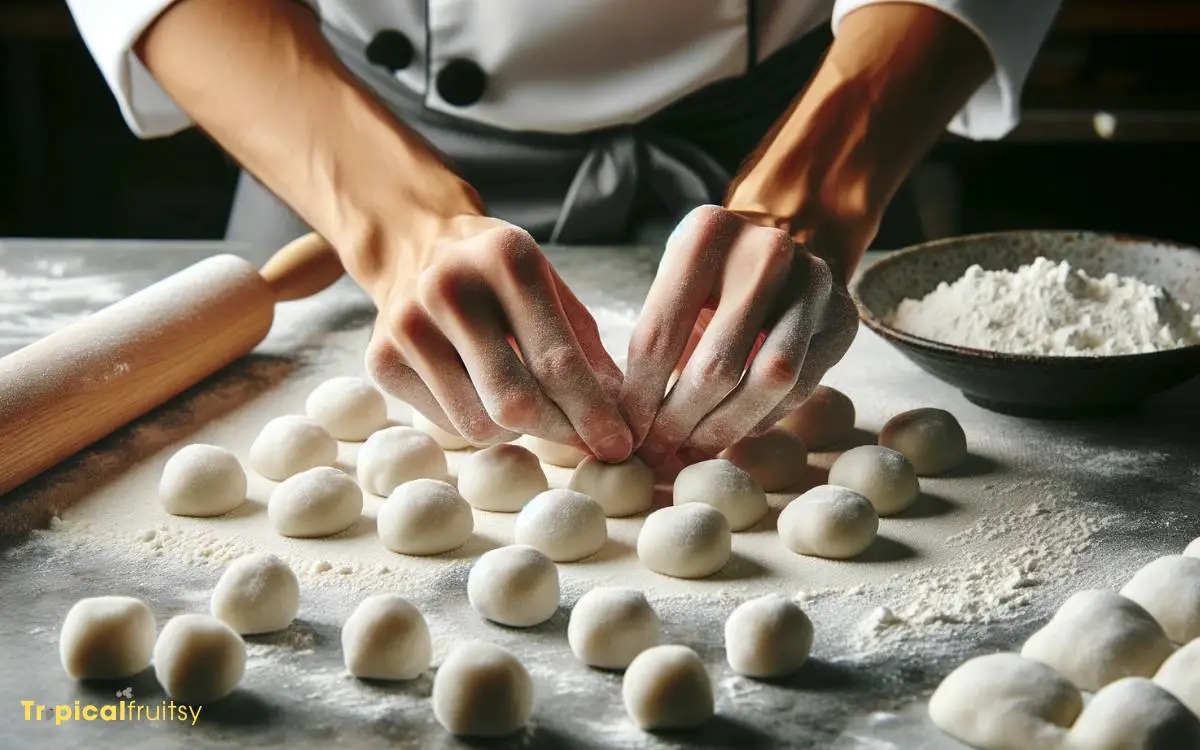
Shaping the mochi balls requires meticulous attention to the thickness of the dough to ensure even cooking and texture.
Accurate measurement of durian filling is critical to maintain consistency and avoid rupturing the dough during sealing.
Mastering the sealing technique is essential to create a smooth, aesthetically pleasing surface that encapsulates the filling completely.
Dough Thickness Uniformity
To ensure a consistent texture and taste, maintain uniform thickness when shaping your mochi balls. Achieving even dough distribution is paramount in the creation of durian mochi, as it directly impacts the culinary experience.
Each ball should be methodically measured and rolled to prevent variations in the cooking process and ensure that the mochi encapsulates the durian filling adequately.
Use a digital kitchen scale to weigh each portion of mochi dough for accuracy. Employ a rolling pin with adjustable thickness rings to achieve consistent dough thickness.
Perform a tactile check by gently pressing the dough to feel for any uneven spots or varying thicknesses.
Durian Filling Quantity
We must carefully measure the durian filling to ensure each mochi ball has a harmonious balance of fruit and dough.
Precise quantification is essential; typically, a ratio of one part durian puree to two parts mochi dough by weight provides an optimal taste and texture experience.
For uniformity, use a digital scale to allocate approximately 15 grams of durian filling per mochi ball. This specific measurement ensures a consistent core within the pliable mochi exterior, allowing for a uniform distribution of flavors upon consumption.
When shaping the mochi balls, maintain a clean working surface and dust hands with potato starch to prevent sticking.
Encase the measured filling with the prepared dough, meticulously sealing it to avoid any leakage during the cooking process.
Sealing Technique Mastery
How does one achieve a perfectly sealed mochi to encapsulate the durian filling without compromising its shape or integrity? The sealing technique is critical in the crafting of mochi.
A precise, deliberate method ensures the mochi’s smooth exterior and consistent spherical form, essential for a professional presentation and textural experience.
Consider the following steps to refine the sealing technique:
- Dusting: Minimally dust your hands with potato or corn starch to prevent sticking without creating a thick outer layer that could detach or become chewy.
- Pinching: Gently but firmly pinch the edges of the flattened mochi dough upwards, overlapping each section until the filling is completely enclosed.
- Rolling: After sealing, roll the mochi ball between your palms in a circular motion to smooth out seams and create a uniform spherical shape.
Step 5: Assemble the Durian Mochi
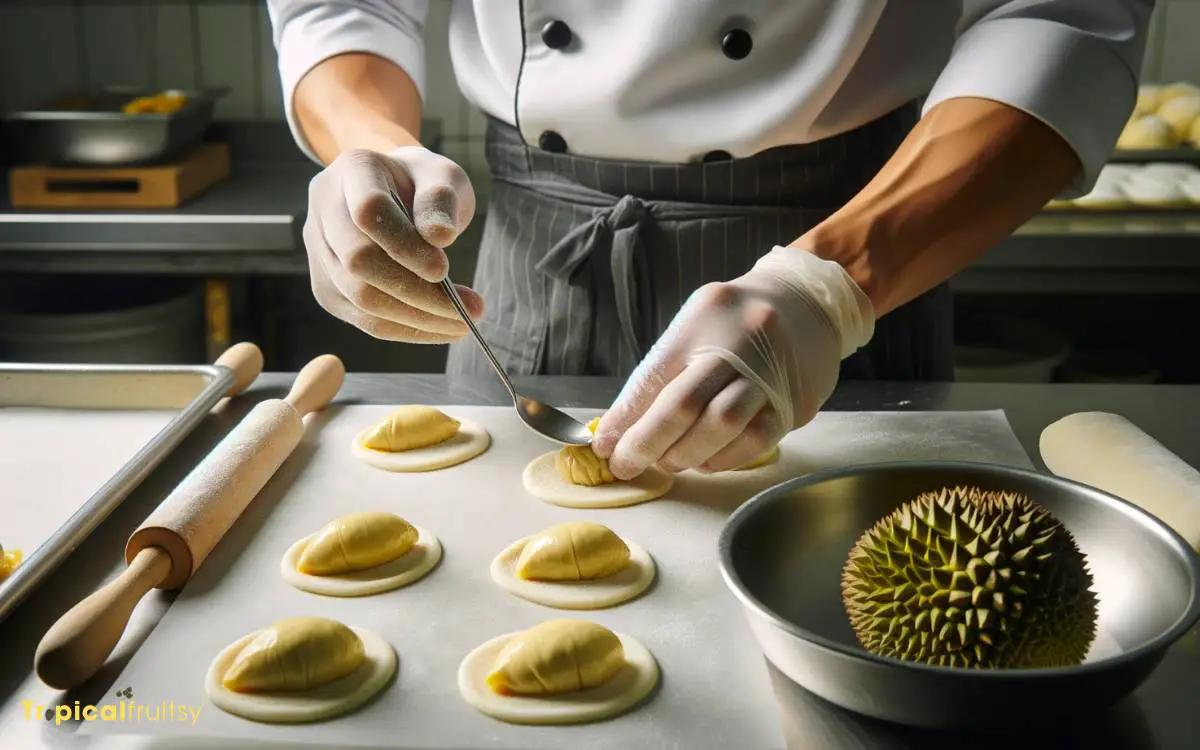
Assembling the durian mochi involves carefully encasing the pungent durian paste in the prepared glutinous rice dough. Begin by dusting your work surface with a liberal amount of potato starch to prevent sticking.
Flatten the rice dough into a circular shape, maintaining an even thickness throughout. Place a premeasured amount of durian paste at the center of the dough circle.
Gently lift the edges of the dough upwards, pleating as you go, to envelop the durian paste completely. Ensure the mochi is sealed tightly to avoid leakage of the filling during serving.
Pinch and twist the dough at the top to finalize the seal. The artistry of mochi assembly requires a delicate balance between firmness and gentleness to maintain the integrity of the shape.
Step 6: Chill and Set Mochi

Once the durian mochi has been assembled, it should be placed in the refrigerator to chill for at least two hours to allow the mochi to firm up and the flavors to meld.
This crucial step transforms the mochi from a soft, pliable state into a delightfully chewy confection with a harmonious distribution of durian flavor.
During this phase, the mochi dough’s texture stabilizes, and the filling sets, preventing any potential seepage when served.
To ensure optimal results:
- Arrange the mochi on a tray lined with parchment paper to prevent sticking.
- Cover the mochi with plastic wrap to avoid the absorption of other odors from the refrigerator.
- Maintain a consistent temperature to prevent any change in texture.
Step 7: Serve and Enjoy
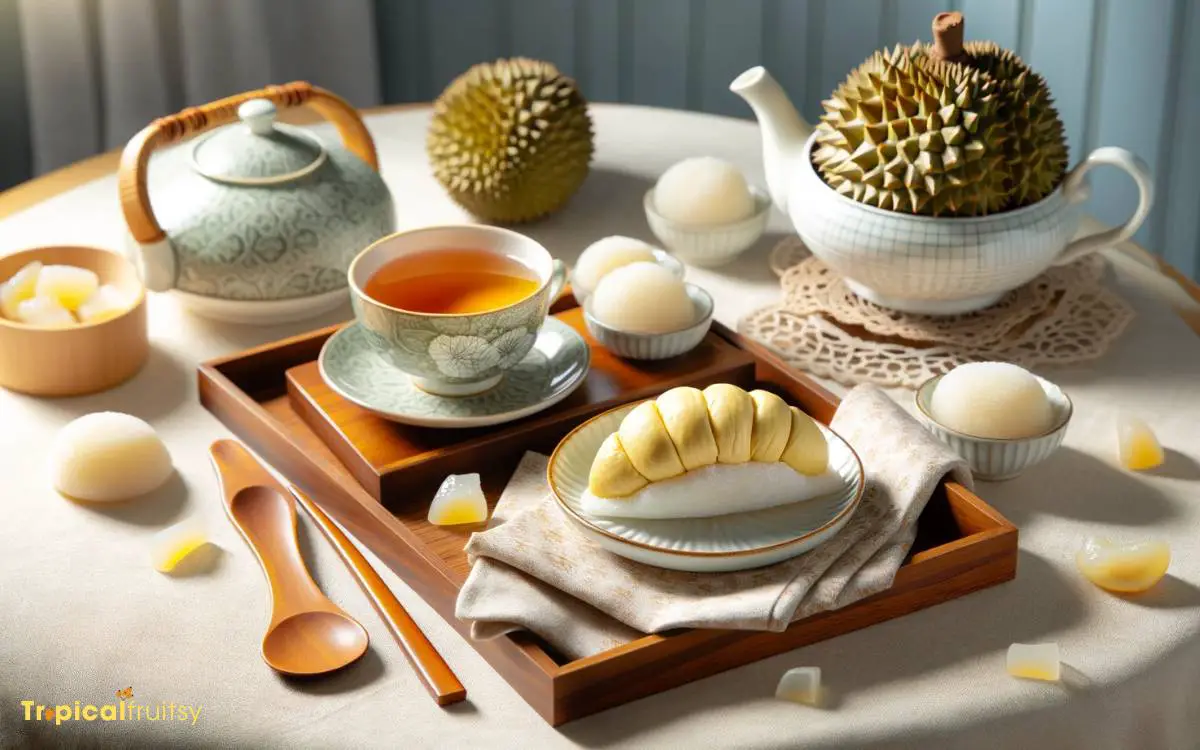
Having chilled for the requisite time, the durian mochi is now ready to be presented and savored by enthusiasts of this unique treat.
To ensure optimal gustatory pleasure, it is imperative to maintain the mochi at a cool temperature until the moment of consumption.
This preserves the delicate texture and the intricate balance of the durian’s potent aroma with the subtle sweetness of the mochi dough.
When serving, employ a clean, sharp knife to slice the mochi into manageable pieces, wiping the blade between cuts to prevent sticking and to uphold the integrity of each mochi’s exterior.
Present the slices on a chilled plate or a traditional Japanese serving dish to enhance the aesthetic appeal.
Instruct consumers to partake of the durian mochi with their fingers, thus allowing a direct, tactile connection to this exquisite confectionery.
Conclusion
The preparation of durian mochi involves a meticulous process of crafting mochi dough, creating a rich durian filling, and delicately assembling the components into a traditional confection.
Mastery of this culinary endeavor offers a unique gustatory experience, merging the pungent allure of durian with the tender bite of mochi.
Adherence to the outlined steps ensures a successful integration of these distinct elements, culminating in a dessert that encapsulates both cultural authenticity and innovative gastronomy.






